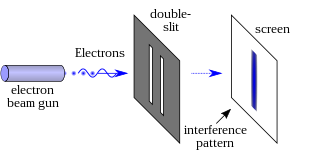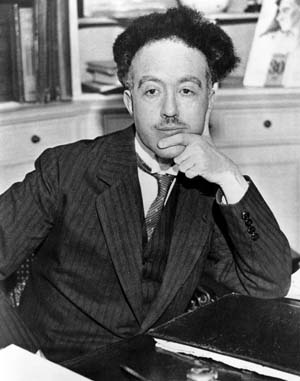Related Research Articles

In modern physics, the double-slit experiment demonstrates that light and matter can satisfy the seemingly incongruous classical definitions for both waves and particles, which is considered evidence for the fundamentally probabilistic nature of quantum mechanics. This type of experiment was first performed by Thomas Young in 1801, as a demonstration of the wave behavior of visible light. At that time it was thought that light consisted of either waves or particles. With the beginning of modern physics, about a hundred years later, it was realized that light could in fact show both wave and particle characteristics. In 1927, Davisson and Germer and, independently George Paget Thomson and his research student Alexander Reid demonstrated that electrons show the same behavior, which was later extended to atoms and molecules. Thomas Young's experiment with light was part of classical physics long before the development of quantum mechanics and the concept of wave–particle duality. He believed it demonstrated that Christiaan Huygens' wave theory of light was correct, and his experiment is sometimes referred to as Young's experiment or Young's slits.
In theories of quantum gravity, the graviton is the hypothetical quantum of gravity, an elementary particle that mediates the force of gravitational interaction. There is no complete quantum field theory of gravitons due to an outstanding mathematical problem with renormalization in general relativity. In string theory, believed by some to be a consistent theory of quantum gravity, the graviton is a massless state of a fundamental string.

In physics, interference is a phenomenon in which two coherent waves are combined by adding their intensities or displacements with due consideration for their phase difference. The resultant wave may have greater intensity or lower amplitude if the two waves are in phase or out of phase, respectively. Interference effects can be observed with all types of waves, for example, light, radio, acoustic, surface water waves, gravity waves, or matter waves as well as in loudspeakers as electrical waves.
A photon is an elementary particle that is a quantum of the electromagnetic field, including electromagnetic radiation such as light and radio waves, and the force carrier for the electromagnetic force. Photons are massless, so they always move at the speed of light when in vacuum, 299792458 m/s. The photon belongs to the class of boson particles.

The speed of light in vacuum, commonly denoted c, is a universal physical constant that is exactly equal to 299,792,458 metres per second. According to the special theory of relativity, c is the upper limit for the speed at which conventional matter or energy can travel through space.

The theory of relativity usually encompasses two interrelated physics theories by Albert Einstein: special relativity and general relativity, proposed and published in 1905 and 1915, respectively. Special relativity applies to all physical phenomena in the absence of gravity. General relativity explains the law of gravitation and its relation to the forces of nature. It applies to the cosmological and astrophysical realm, including astronomy.

Louis Victor Pierre Raymond, 7th Duc de Broglie was a French aristocrat and physicist who made groundbreaking contributions to quantum theory. In his 1924 PhD thesis, he postulated the wave nature of electrons and suggested that all matter has wave properties. This concept is known as the de Broglie hypothesis, an example of wave–particle duality, and forms a central part of the theory of quantum mechanics.
A timeline of atomic and subatomic physics.
Matter waves are a central part of the theory of quantum mechanics, being half of wave–particle duality. All matter exhibits wave-like behavior. For example, a beam of electrons can be diffracted just like a beam of light or a water wave.
An Electron interferometer is an interferometer based on exploiting the wave character of electrons.
An atom interferometer is an interferometer which uses the wave character of atoms. Similar to optical interferometers, atom interferometers measure the difference in phase between atomic matter waves along different paths. Today, atomic interference is typically controlled with laser beams. Atom interferometers have many uses in fundamental physics including measurements of the gravitational constant, the fine-structure constant, the universality of free fall, and have been proposed as a method to detect gravitational waves. They also have applied uses as accelerometers, rotation sensors, and gravity gradiometers.

In physics, a neutron interferometer is an interferometer capable of diffracting neutrons, allowing the wave-like nature of neutrons, and other related phenomena, to be explored.

The annus mirabilis papers are the four papers that Albert Einstein published in Annalen der Physik, a scientific journal, in 1905. These four papers were major contributions to the foundation of modern physics. They revolutionized science's understanding of the fundamental concepts of space, time, mass, and energy. Because Einstein published these remarkable papers in a single year, 1905 is called his annus mirabilis.
- The first paper explained the photoelectric effect, which established the energy of the light quanta , and was the only specific discovery mentioned in the citation awarding Einstein the 1921 Nobel Prize in Physics.
- The second paper explained Brownian motion, which established the Einstein relation and led reluctant physicists to accept the existence of atoms.
- The third paper introduced Einstein's theory of special relativity, which used the universal constant speed of light to derive the Lorentz transformations.
- The fourth, a consequence of the theory of special relativity, developed the principle of mass–energy equivalence, expressed in the famous equation and which led to the discovery and use of atomic energy decades later.
In physics, aether theories propose the existence of a medium, a space-filling substance or field as a transmission medium for the propagation of electromagnetic or gravitational forces. "Since the development of special relativity, theories using a substantial aether fell out of use in modern physics, and are now replaced by more abstract models."
Quantum mechanics is the study of matter and its interactions with energy on the scale of atomic and subatomic particles. By contrast, classical physics explains matter and energy only on a scale familiar to human experience, including the behavior of astronomical bodies such as the moon. Classical physics is still used in much of modern science and technology. However, towards the end of the 19th century, scientists discovered phenomena in both the large (macro) and the small (micro) worlds that classical physics could not explain. The desire to resolve inconsistencies between observed phenomena and classical theory led to a revolution in physics, a shift in the original scientific paradigm: the development of quantum mechanics.
The theoretical and experimental justification for the Schrödinger equation motivates the discovery of the Schrödinger equation, the equation that describes the dynamics of nonrelativistic particles. The motivation uses photons, which are relativistic particles with dynamics described by Maxwell's equations, as an analogue for all types of particles.
The history of quantum mechanics is a fundamental part of the history of modern physics. The major chapters of this history begin with the emergence of quantum ideas to explain individual phenomena—blackbody radiation, the photoelectric effect, solar emission spectra—an era called the Old or Older quantum theories. Building on the technology developed in classical mechanics, the invention of wave mechanics by Erwin Schrödinger and expansion by many others triggers the "modern" era beginning around 1925. Paul Dirac's relativistic quantum theory work lead him to explore quantum theories of radiation, culminating in quantum electrodynamics, the first quantum field theory. The history of quantum mechanics continues in the history of quantum field theory. The history of quantum chemistry, theoretical basis of chemical structure, reactivity, and bonding, interlaces with the events discussed in this article.

Physics is a scientific discipline that seeks to construct and experimentally test theories of the physical universe. These theories vary in their scope and can be organized into several distinct branches, which are outlined in this article.
A hallmark of Albert Einstein's career was his use of visualized thought experiments as a fundamental tool for understanding physical issues and for elucidating his concepts to others. Einstein's thought experiments took diverse forms. In his youth, he mentally chased beams of light. For special relativity, he employed moving trains and flashes of lightning to explain his most penetrating insights. For general relativity, he considered a person falling off a roof, accelerating elevators, blind beetles crawling on curved surfaces and the like. In his debates with Niels Bohr on the nature of reality, he proposed imaginary devices intended to show, at least in concept, how the Heisenberg uncertainty principle might be evaded. In a profound contribution to the literature on quantum mechanics, Einstein considered two particles briefly interacting and then flying apart so that their states are correlated, anticipating the phenomenon known as quantum entanglement.
In physics, the gravitational Aharonov-Bohm effect is a phenomenon involving the behavior of particles acting according to quantum mechanics while under the influence of a classical gravitational field. It is the gravitational analog of the well-known Aharonov–Bohm effect, which is about the quantum mechanical behavior of particles in a classical electromagnetic field.
References
- ↑ Lan, S-Y et al.; "A Clock Directly Linking Time to a Particle's Mass", Science 1 February 2013: Vol. 339 no. 6119 pp. 554–557 doi : 10.1126/science.1230767
- 1 2 3 Sanders, R.; "A rock is a clock: physicist uses matter to tell time", UC Berkeley News Center, (retrieved 4 July 2014)
- 1 2 3 Müller, H.; "Quantum mechanics, matter waves, and moving clocks", "To be published in the proceedings of the International School of Physics "Enrico Fermi" 2013", arXiv:1312.6449v1
- 1 2 Wolf, P. et al.; "Testing the Gravitational Redshift with Atomic Gravimeters?" (2011) arXiv : 1106.3412
- 1 2 Wolf, P. et al.; "Reply to the comment on: 'Does an atom interferometer test the gravitational redshift at the Compton frequency?'" (2012) arXiv : 1201.1778
- ↑ Pease, R.; "The time? About a quarter past a kilogram", Nature.com news, 2013